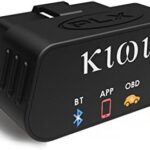Experiencing issues with your 1998 Jeep Grand Cherokee’s check engine light and finding your scan tool won’t connect? A non-responsive OBD2 port can be a frustrating roadblock when trying to diagnose vehicle problems. This guide will walk you through troubleshooting steps to get your OBD2 port working again, focusing on common causes and solutions specific to the ’98 Grand Cherokee.
The OBD2 (On-Board Diagnostics II) port, officially known as the Data Link Connector (DLC), is essential for accessing your vehicle’s computer system. It provides crucial data for diagnosing issues, from simple sensor malfunctions to more complex engine or transmission problems. If your scan tool fails to power up or connect when plugged into the OBD2 port, the issue often lies within the port’s power or ground supply.
Let’s investigate the potential culprits behind a dead OBD2 port in your ’98 Grand Cherokee:
Checking the Power Supply to the DLC
The OBD2 port requires both power and ground to function correctly. On your 1998 Jeep Grand Cherokee, the power supply to the DLC is sourced from fuse F17, located in the Power Distribution Center (PDC) – often found under the hood.
- Locate Fuse F17: Consult your owner’s manual or the PDC cover diagram to pinpoint the exact location of fuse F17.
- Inspect the Fuse: Visually examine the fuse. A blown fuse will typically have a broken filament inside.
- Test the Fuse: For a more definitive check, use a fuse tester or a multimeter to confirm continuity. Replace fuse F17 with a fuse of the same amperage if it’s blown.
Important Note: While fuse F17 also powers other circuits, such as the headlamps, it’s still possible for this fuse to be the sole issue affecting your OBD2 port. Always replace a blown fuse with the correct type and amperage.
Verifying the Ground Connections
Ground issues are another common reason for OBD2 port malfunction. The ’98 Grand Cherokee DLC utilizes two ground pins, which are crucial for completing the electrical circuit.
- Locate the DLC Ground Pins: On the top row of the OBD2 port, the second and third pin cavities from the left are designated as ground.
- Trace Ground Wires: These ground wires are typically routed to a common grounding point. In the ’98 Grand Cherokee, they often connect to the oil dipstick tube mounting bracket stud on the left side of the engine compartment.
- Inspect Ground Connections: Check the wires at the grounding point for any signs of corrosion, looseness, or damage. Clean any corrosion and ensure the connections are tight and secure.
Testing for Voltage at the DLC
To confirm if power is reaching the OBD2 port, use a voltmeter.
- Identify Power and Ground Pins: Locate the power pin cavity on the bottom row, far right. Use one of the ground pin cavities on the top row (second or third from the left) as your ground reference.
- Voltage Measurement: With the ignition ON, use a voltmeter to measure the voltage between the power pin and a ground pin. You should read approximately 12 VDC.
- Interpret Results:
- 12 VDC Reading: Indicates power is reaching the port. If your scan tool still doesn’t work, the issue might be with the scan tool itself or potentially a communication problem (SCI circuits), which requires further, more advanced diagnosis.
- No Voltage Reading: Suggests a problem with the power supply (fuse, wiring) or ground. Re-check fuse F17 and the ground connections meticulously.
Additional Checks
- DLC Pin Condition: Inspect the pins inside the OBD2 port for corrosion or damage. Bent or expanded pins can prevent proper connection. Ensure the pins are clean and in good condition.
By systematically checking the fuse, ground connections, and power supply to your 1998 Jeep Grand Cherokee’s OBD2 port, you can often pinpoint and resolve the issue preventing your scan tool from connecting. If these basic checks don’t solve the problem, it may indicate a more complex communication issue within the vehicle’s diagnostic system, potentially requiring professional diagnosis.
